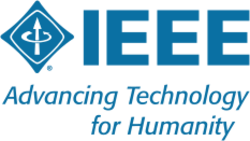Institute of Electrical and Electronics Engineers facts for kids
 |
|
| Abbreviation | IEEE |
|---|---|
| Founded | January 1, 1963 |
| Type | Professional association |
| Legal status | 501(c)(3) public charity |
| Focus | Electrical, electronics, communications, and computer engineering |
| Location | |
| Origins | Merger of the American Institute of Electrical Engineers and the Institute of Radio Engineers |
| Method | Industry standards, conferences, publications |
|
Members
|
486,000+ |
|
Key people
|
Kathleen Kramer |
|
Revenue
|
US$646.4 million (2024) |
The Institute of Electrical and Electronics Engineers (IEEE) is a huge group of experts in electrical engineering, electronics engineering, and other related fields. It's like a global club for people who work with technology. Their main goal is to help technology grow and improve for everyone's benefit.
IEEE has offices in New York City and Piscataway, New Jersey. It was created in 1963 when two older groups, the American Institute of Electrical Engineers and the Institute of Radio Engineers, joined together. As of 2025, IEEE has over 486,000 members in 190 countries. More than two-thirds of its members live outside the United States.
Contents
The History of IEEE
How IEEE Started
The story of IEEE began in 1884 with the American Institute of Electrical Engineers. Later, in 1912, another group called the Institute of Radio Engineers was formed. At first, the AIEE was bigger. But by the mid-1950s, the IRE had more members, especially students. These two important groups decided to combine their efforts in 1963. This is how the IEEE we know today was created.
IEEE Locations
The main office for IEEE is in New York City. However, most of their day-to-day work happens at the IEEE Operations Center. This center is located in Piscataway, New Jersey, and it opened in 1975.
What IEEE Does
Technical Societies: Learning and Sharing
IEEE has 39 special groups called "technical societies." Each society focuses on a specific area of technology or engineering. These groups help members learn more, share ideas, and connect with others. They do this by publishing magazines, holding conferences, and offering ways to network.
Here are some of the areas these societies cover:
- Aerospace and Electronic Systems
- Antennas & Propagation
- Broadcast Technology
- Circuits and Systems
- Communications
- Electronics Packaging
- Computational Intelligence
- Computer Science
- Consumer Technology
- Control Systems
- Dielectrics & Electrical Insulation
- Education
- Electromagnetic Compatibility
- Electron Devices
- Engineering in Medicine and Biology
- Geoscience and Remote Sensing
- Industrial Electronics
- Industry Applications
- Information Theory
- Instrumentation & Measurement
- Intelligent Transportation Systems
- Magnetics
- Microwave Theory and Technology
- Nuclear and Plasma Sciences
- Oceanic Engineering
- Photonics
- Power Electronics
- Power & Energy
- Product Safety Engineering
- Professional Communication
- Reliability
- Robotics and Automation
- Signal Processing
- Social Implications of Technology
- Solid-State Circuits
- Systems, Man, and Cybernetics
- Technology and Engineering Management
- Ultrasonics, Ferroelectrics, and Frequency Control
- Vehicular Technology
Global Reach: Connecting Members Worldwide
IEEE is divided into 10 global regions. These regions help support members and volunteers in different parts of the world. Each region has smaller "sections" that work directly with local members. This helps IEEE connect with its members no matter where they live.
IEEE Foundation: Supporting Technology
The IEEE Foundation is a charity group started in 1973. Its goal is to support and promote learning about technology. It also encourages new ideas and excellence in the field. The Foundation is separate from IEEE, but they work very closely. The people on the Foundation's board must be active IEEE members.
The Foundation first helped with awards for great achievements in technology. But as more donations came in, they expanded their work. Now, they support many programs. These include educational projects, humanitarian efforts, and preserving the history of technology. By the end of 2014, the Foundation had nearly $45 million to help these important causes.
Membership Geographic Activities: Helping Members Grow
IEEE's Membership Geographic Activities (MGA) group focuses on helping members and attracting new ones. MGA creates chances for volunteers to attend conferences. They also help organize events related to technology, science, and helping people. This gives members a professional community where they can interact and feel like they belong.
See also
 In Spanish: Institute of Electrical and Electronics Engineers para niños
In Spanish: Institute of Electrical and Electronics Engineers para niños
- Certified Software Development Professional (CSDP) program of the IEEE Computer Society
- Glossary of electrical and electronics engineering
- Engineering and Technology History Wiki
- Eta Kappa Nu – IEEE HKN Honor society (joined IEEE in 2010)
- IEEE Standards Association
- Institution of Engineering and Technology (UK)
- International Electrotechnical Commission (IEC)
- List of IEEE awards
- List of IEEE conferences
- List of IEEE fellows

